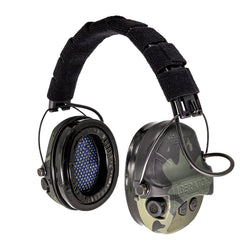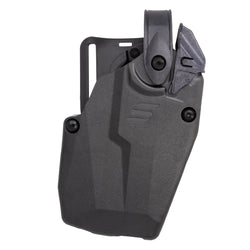The USS Constitution, famously known as “Old Ironsides,” has the distinction of being the oldest commissioned warship afloat in the world. She remains preserved in Boston, where she was launched in 1797 before gaining fame during the War of 1812, when British cannonballs were seen to bounce off her thick oak timber hull.
The often overlooked part of the story is that the USS Constitution was also one of six frigates authorized by the United States Congress with the Naval Act of 1794. She remains the only one to have survived war, time, and the elements.
Not the First U.S. Warship
The USS Constitution was among the first six frigates, but the very first U.S. warship was the former merchant vessel Black Prince, which was purchased by the Naval Committee of the Continental Congress in October 1775 and renamed the Alfred.

Serving with the Continental Navy, the forerunner of the United States Navy, USS Alfred was credited with capturing 12 British Royal Navy and merchant ships. However, the vessel was in turn captured off the coast of Barbados in March 1778 and subsequently served with the Royal Navy as a 20-gun sloop until 1782. Sold after the American Revolution, the ultimate fate of the ship remains unclear.
The remainder of the Continental Navy’s other ships that were built or purchased were also sold off, with the USS Alliance being the final ship to be retired and sold on August 1, 1785. That marked the end of the Continental Navy, which is noteworthy in that the American Revolution was almost lost in infancy due to a lack of naval power. Final victory was the result of control of the seas as much as it was due to successes on land. It would take only a few years for the fledgling United States of America to understand the errors of its ways.
One reason that the United States didn’t see a need for a navy was its great expense, even as its relations with Great Britain were strained.
Under the United States Constitution, the commander-in-chief of the armed forces was the president, while Congress was empowered to levy and collect taxes for national defense. The United States had the legal authority to create an army and navy, yet in the early years of the nation, there were differing views on whether such forces were necessary.
The issue resolved itself due to the realities of the world.
Sailing trade routes remained a dangerous enterprise for American merchant vessels. In 1792, the issue became further complicated as the Barbary pirates of North Africa began to plunder American ships in the Mediterranean, while Britain then blocked American vessels from the French West Indies due to its renewed war with France. The dominant Federalist faction in the U.S. government sought to recreate a small United States Navy to address these concerns.
On January 2, 1794, the Third Congress of the United States of America resolved to create “a naval force, adequate to the protection of the United States against the Algerine corsairs.”
The Original Six U.S. Navy Frigates
It was agreed that six new 204-foot frigates would be built simultaneously at six different shipyards along the U.S. Atlantic coast. Designed by Joshua Humphreys, a noted Philadelphia shipbuilder, the six warships would sail under the names Constitution, Constellation, United States, Congress, President, and Chesapeake.
Despite the lessening of tensions with Morocco and Algiers the following year, construction continued, with three (including Constitution) commissioned and entering service in 1797, while all six were completed by 1800.
USS Constitution
The only surviving frigate of the original six, USS Constitution, which was rated at 44 guns, was launched from Edmund Hartt’s shipyard in Boston on October 21, 1797. It could be argued that the warship truly embodied the United States, with timbers used in her construction coming from Maine (not yet a state) to Georgia, while American patriot Paul Revere supplied copper bolts and spikes.

USS Constitution served as the flagship of the Santo Domingo Station, aiding in the capture of multiple ships during the Quasi-War with France. She later served as the flagship of the U.S. Navy’s Mediterranean Squadron, which bombarded Tripoli in what is now modern Libya and subsequently successfully blockaded the port, leading to the peace terms with Algiers and later Tunisia.
During the War of 1812, USS Constitution engaged the Royal Navy frigate HMS Guerriere, where rounds fired at the American warship seemed to bounce off, leading to her famous nickname. The frigate remained in active service, carrying out a variety of missions, including patrolling the west coast of Africa for slavers, before being later used to train midshipmen at the U.S. Naval Academy in Annapolis, Maryland.
Saved numerous times from being scraped, she returned to commissioned status in 1931 and remains in Boston, maintained by a partnership between the Naval History and Heritage Command’s Detachment Boston, the USS Constitution Museum, and the National Park Service.
USS Chesapeake
Launched on December 2, 1799, at the Gosport Navy Yard, Virginia, and commissioned on May 22, 1800, USS Chesapeake had the distinction of being “disowned” by Humphreys due to changes made during her construction.
Although initially planned as a 44-gun warship, the design was altered by Master Constructor Josiah Fox to a 36-gun vessel of just 152.8 feet in length. It has been suggested that the change may have been due to materials being diverted to complete the USS Constellation, while there has been speculation that Fox simply thought his design was better than that of Humphreys.

The warship engaged privateers during the Quasi-War with France, including in a chase of the privateer La Jeune Creole lasting more than 50 hours.
The frigate was later at the center of the “Chesapeake-Leopard” affair, a naval engagement off the coast of Virginia in June 1807, between the Royal Navy’s HMS Leopard and the USS Chesapeake, as the British warship sought deserters. The two ships exchanged fire, resulting in the death of four American sailors and damage to the vessel, while the Royal Navy removed four sailors it claimed had deserted.
Just six years later, the USS Chesapeake saw action during the War of 1812, but where the USS Constitution will forever be remembered for her victories, the same can’t be said of the USS Chesapeake. Instead, she was captured by the Royal Navy’s HMS Shannon, taken as a prize to England, where she was later broken up. Her timbers were used in the construction of the Chesapeake Mill, a watermill in Wickham, Hampshire, England.
USS Congress
Built at the Portsmouth Naval Shipyard in New Hampshire, the USS Congress underwent design alterations, with the warship being rated at 37 guns. Moreover, her construction was temporarily interrupted upon the conclusion of a peace treaty with Algiers, only to resume as hostilities began with France.
During the Quasi-War with France, USS Congress was dispatched to protect American interests from unlawful French privateers operating in the Caribbean.

However, just six days into her maiden voyage, she lost her mast and was forced back to the United States for repairs at Hampton Roads, Virginia. Following the completion of those repairs, she resumed her mission and, in August 1800, recaptured the merchant brig Experiment that had been seized by the French only days earlier.
The USS Congress was then dispatched to the Mediterranean during the First Barbary War and assisted in the blockade of Tunisia. After serving as a classroom for midshipman training, she returned to active duty during the War of 1812. Sailing with USS President, USS Congress captured nine prizes and engaged multiple British vessels.
During a year-long cruise to the Pacific Ocean, USS Congress became the first United States Navy ship to visit China at Guangzhou, Canton. She later operated in the West Indies and the Gulf of Mexico, hunting pirates.
The frigate served as a receiving ship, processing U.S. Navy recruits, before it was determined she was unfit for repairs. USS Congress was broken up at the Norfolk Navy Yard in 1834.
USS Constellation
Constructed in Baltimore, USS Constellation saw service in the Quasi-War with France, capturing the frigate Insurgente on February 9, 1799, making the first victory by an American-designed and domestically-built warship. Just a year later, she engaged with and badly damaged the French frigate Vengeance.
During the War of 1812, USS Constellation was prevented from reaching the open sea while in port at Hampton Roads, Virginia, but took part in the defense of the Craney Islands. She was dispatched as part of another Mediterranean Squadron to confront the Barbary pirates after the conflict with the British, and aided in the capture of the Algerian frigate Mashuda.

The frigate saw service in the Atlantic, protecting American interests, and as part of the West India Squadron, which sought to eradicate pirates and intercept slavers.
In the 1840s, the USS Constellation circumnavigated the globe, serving with the East India Squadron, and safeguarded U.S. interests during the Opium Wars between Great Britain and China. The warship visited the Hawaiian Islands in May 1843 to deter British efforts to gain control of the islands, and made several port calls in South America.
USS Constellation was broken up in Norfolk, Virginia, in 1853.
USS President
Built in New York City and launched in April 1800, USS President featured a slightly modified design, based on experience from the original three frigates. She entered service, missing the Quasi-War with France, but sailed for the Mediterranean, serving as the flagship of Commodore Richard Dale and then later taking part in actions against Tripoli.
In May 1811, USS President took part in the “Little Belt Affair,” engaging the Royal Navy sloop-of-war HMS Little Belt, believing her to be the aforementioned frigate HMS Guerriere, which had impressed American sailors who were thought to have deserted from the Royal Navy. The ships exchanged fire, with each commanding officer claiming the other fired first. It increased tensions that eventually led to the War of 1812, in which the USS President took part in several actions.

She pursued a fleet of British merchant ships, sailing within a day’s journey of the English Channel, and captured seven merchants. On a subsequent sortie, USS President captured a packet ship loaded with British currency and an additional eight merchant vessels.
After a year spent blockaded in port by the Royal Navy, the frigate’s luck ran out after suffering damage while heading out of New York Harbor in January 1815. Not knowing that a peace had been reached, she engaged the 40-gun fifth-rate warship HMS Endymion; however, the smaller Royal Navy vessel proved far more maneuverable. Three additional Royal Navy frigates arrived, and Commodore Stephen Decatur, Jr., of the U.S. Navy was forced to surrender. Decatur and his crew were taken prisoner to Bermuda before being paroled with news of the cessation of hostilities.
The Royal Navy took the American frigate into its service as HMS President, only for the warship to be broken up in 1817 in Portsmouth, England.
USS United States
Built in Philadelphia, USS United States was one of the first three frigates to enter service with the U.S. Navy. She protected merchant shipping during the Quasi-War with France and captured the French privateer schooner La Tartueffe.
Refitted in 1810, she later took part in a battle with the Royal Navy’s HMS Macedonian during the War of 1812. That encounter was notable as then-Captain Stephen Decatur, Jr., was told by British Captain John S. Garden, commanding officer of Macedonian, that if the two ships ever med in war, the British warship would be the victor. That may have served to inspire Decatur, and when the two met on October 25, 1812, it was HMS United States that won the day.

Following the end of hostilities with Great Britain, the USS United States took part in patrols in the Mediterranean. After another refit, it served as the flagship of the Pacific Squadron and was later detailed to the African Squadron to suppress the illicit slave trade.
Among the sailors to serve on the frigate was Herman Melville, the future author of Moby-Dick.
When the American Civil War broke out in 1861, the USS United States had been decommissioned, but along with the USS Constitution, it was one of the only two remaining of the original six frigates. She had remained at the Norfolk Navy Yard, but the actual plans of what was to be her fate were unclear. The Union fire crews that set fire to other abandoned ships in April 1861 before retreating from the facilities opted not to burn the old vessel.
The Confederate Navy, pressed for any and all warships, refitted the vessel and commissioned her as the CSS United States, although she was also called the CSS Confederate States. She served as a receiving ship, but just a year later was ordered sunk in the Elizabeth River, Virginia, to form an obstruction to the Union forces when the Confederates were forced to abandon the navy yard.
The Union forces captured the Norfolk Navy Yard in May 1862 and shortly thereafter raised the USS United States. The frigate was towed to the yard, where she remained for the rest of the war. In 1865, the ship was broken up and its wood sold.

At that point, USS Constitution remained the final survivor of the six original frigates!
This article is part of our series honoring the U.S. Navy’s 250th birthday—see the other stories in the series for more history and insights.
Origins of the U.S. Navy
- 13 October 1775: The Birth of a Sea Power.
- John Paul Jones: Father of America’s Navy
- The History of the U.S. Navy’s First Six Frigates
- U.S. Naval Battles of the Revolutionary War
Navy Pioneers & Heroes
- History of U.S. Naval Infantry
- Forged in Fire: The Origins of the Navy SEALS
- Unsung Heroes of the U.S. Navy
Naval Hardware
Honoring the Legacy









